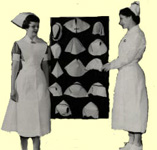 |
Terms Frequently Used in these Pages
Nurse
Nursing
Shortage, Shortage, Current Crisis Nursing Shortage
The Industry
Management
Overtime,
Mandatory Overtime, Involuntary Overtime, Involuntary and Uncompensated
Overtime
Resource/ Resource Requirements
Nursing Glut. A misunderstanding
of the Resource Pool
Differentials
Holidays [believe it or not this
demands an explanation!]
Nurse:
In these web pages the term "Nurse" refers
to the RN providing direct patient care . Unless stated otherwise, it does
not differentiate between the RN who is BSN trained vs Associate or Diploma
Trained.
It also includes the organizations that
represent the nurse as defined above. It does not include Nurse executives
or Nurse administrators whose job function falls under management within
the
Industry.
aaa
Implicit is the understanding there are
others providing direct patient care who fall under the supervision of
the Nursing Departments in the Industry , and/or are mentioned in
legislation regarding Nurses. These include Nurse's Aides, LPNs/
LVNs, Clinical Specialists, Nurse Practitioners, Certified Nurse Midwives
and Nurse anesthetists. [Understanding of these last 5 titles is provided
in Nursing Education ] Within
these pages those persons are not included in the use of Nurse as defined
above unless comment is made otherwise.
aaaaaa
Nursing
Shortage, the Shortage, Current Crisis Nursing Shortage:
In these webpages Nursing Shortage
refers to the absence of sufficient Nurses to meet market demand.
The current Crisis nursing shortage has unique characteristics differing
from previous periods of acute shortage.
As the shortage is seen by the
writer as a long-term problem never adequately addressed, the term current
Crisis nursing shortage is frequently used . It is the understanding
of the writer that the shortage has a long cyclical nature and that
the current Crisis is only an intensification of a long-standing
nursing shortage with roots in the post WW II era when first it began to
exert its effect.
Identification of the shortage historically,
and the unique current attributes marking the current Crisis shortage within
it, occurs in detail in these pages. |
 |
|

 |
The Industry:
In these webpages the term "Industry"
or "The Industry" refers in aggregate to non-profit and public
hospitals, nursing homes, health systems, nursing facilities, home care
agencies, hospice and adult day care programs, and other related health
care facilities and the persons who oversee them, among whom are sometimes
included nurse executives. The Industry is often a consortium of those
entities described above, although it can be the spokesperson for a particular
entity among them. Nurse executives, because of their role in management
and apart from direct patient care, do not fall within the meaning
of the word Nurse as utilized in these pages.
Although the Industry has been the nurse's
primary employment venue since the 1929-1937 period in which private duty
nursing collapsed in response to greater economic forces, the requirements
of, and focus of Managers in the Industry have changed with time and in
response to several exterior forces, with specific markers identifying
them who is in command of the Industry in which nurses are positioned.
See The Industry and history of Hospital
Management.
aaaa
aaaa
aaaa
Management:
In these webpages the term "Management"
refers to those persons or groups of persons who manage the entities identified
in "Industry" above. Because of the current trend of conglomeration
of facilities under large corporate umbrellas, the ability to separate
Management from Industry as defined above is at times less
easily accomplished. There are many levels to Management from
a Nurse's perspective impacting on her job, its requirements, and
environment. Management when used refers to an individual
facility, or locale consortium of facilities' managers and
their agents, unless otherwise implied. Management can, and often
does, include Nurse executives.
|


|
Overtime,
Involuntary Overtime, Mandatory Overtime:
Overtime is working beyond the contractual
time frame as defined by fair labor practice in regards to a 24 hour period
and/or within two work weeks.
Nurses, as essential personnel, are subject
to mandatory overtime from
which other labor sectors of our economy are protected. If a nurse is told
she must provide mandatory overtime , she is in abrogation of her professional
code in not complying, as it is considered patient abandonment, and in
doing so she is endangering her license. Management will whistle blow,
or at least institute disciplinary measures.
Nurses complain mandatory overtime is
routinely used by the Industry to address their routine staffing needs.
Mandatory overtime is usually meant to reflect an extension of a shift
to continue the provision of patient care due to lack of personnel
to meet the oncoming shift's care requirements. When lobbying against control
of mandatory overtime, industry frequently calls it Unavoidable Overtime.
The use of extended work time, however,
is more insidious, as there is an infra structural reliance on the
nurse for mandatory overtime not an extension of the shift. This
form of overtime is better referred toInvoluntary
overtime; It occurs in the form of routinely lost breaks,
meal times, and the need to remain beyond the contractual shift in order
to meet the demands of the shift just ended. During the shift, the involuntary
overtime is usually devoted to pt care. At the end of the shift, the involuntary
overtime is usually devoted to paperwork.
To
add to the weight of the problem, nurses complain that they are frequently
not paid when involuntary overtime is required to meet the requirements
of the shift, and that management denies its existence. When recognized
by management, pay for the lost meals and breaks requires additional, and
bulky, paperwork for the nurse. This tier of involuntary overtime is identified
as Involuntary and Uncompensated overtime.
Involuntary overtime is said by nurses
to be routine in their workdays, while mandatory overtime is used frequently
to staff throughout the week.
|




|
Resource
/ Resource Requirements: A business term for Stuff you Need,
basically. There are technical resource requirements, physical plan resource
requirements, Medical Supply Resource requirements and there are
human resource requirements, among others. In these pages, unless informing
otherwise, "Resource Requirements" refers to the nurses who constitute
a significant percentage of the Industry's Human Resource Requirement and
the largest segment of our health care industry's professionals.
Misidentification of resource availability yielding layoffs, salary stagnation
and erosion of benefits in the 1990s seriously affected the Industry's
ability to assure the continued resource requirement of their entities
was met safely, fluidly, and in absence of detriment to the resource pool
itself.
Glut
,
what WAS that speeding , deadly object?
Its Identification:
The glut refers to the temporary
, brief and misperceived period of nurse overabundance emerging in the
late 1980s and exerting greatest influence in the mid 1990s and until 1998.
Identification of the nursing glut was based in part on the well
publicized increase in nursing school enrollment of the early 1990s,
an increase resultant of the hard won benefit and salary adjustments occurring
to nursing's benefit in the mid-late 1980s and the mistaken belief among
nurses and nursing students that market competition to keep nursing attractive
in the general market economy would continue. Among the gains in union
negotiated contracts in the late 1980s was recognition for years of practice;
This marked the first time in the history of nursing when each year of
service was rewarded with an increase of some sort in many nursing contracts,
and it extended outward from the unionized entities to the non union arena
as non unionized entities sought to maintain their access to the resource
pool. Soon after the modest salary adjustments, wages again stagnated.
The perception of a nursing glut was readjusted in 1998, when word of a
reemergence of the longstanding nursing shortage threatening to reach
proportions beyond any previous experience of the nursing shortage in all
its history began to appear in allied literature, and lay news media.
Its Impact:
Industry,
now almost entirely profit oriented, and widely reporting enormous strain
in the managed care era, took the opportunity of an identified glut
to lay off senior nurses [more expensive -and more experienced], cut back
on ancillary support staff [increasing the remaining nurse's workload and
non nursing tasks], scaled down its ratios of nurse to patients [while
the acuity of those patients was on the rise] and rewarded the nurses remaining
with salary and benefit erosion and a greatly diminished , when already
weak, voice in the hospital hegemony. Through these efforts they gained
further alienation from the nursing pool upon whom the industry depended,
and severed the thin strand of trust holding the industry and nurses together.
Evidence of the Glut Perception, and
Its Reality as a fragile Graduate Nurse Glut:
Perception of the glut was substantiated
by the 1996
Nursing Survey with its preliminary results released soon after
collection, in which a >14% increase in the nation's RNs was identified
as the graduates from nursing schools entered the workforce. The industry,
bolstered by these results, continued to woefully misidentify a nursing
glut for what was in reality a nurse graduate glut, the results of which
are evident in the statistics on future plans of current under 30 year
old RNs to seek non nursing jobs while the number of RNs not
working in nursing at all is increased remarkably . The 2000
Nurse Survey results show 1996-2000 having the highest
number of nurses leaving nursing a over any period since the 1980 first
q 4 yearly nurse survey reflecting the period of 1976-1980.
1995 marks the first year in an [also
cyclic] increase in successful unionizing efforts nationwide, and
nursing strikes yearly increasing until the present. The economic benefits
currently being gained are often announced exuberantly ['28% increase over
three years for hospital gained in recent labor contract!']
back treading and ignoring the devastation of this heavy handed and
irresponsible response to a perceived nursing glut , a period of time in
which nursing and nurses suffered miserably. Nursing salaries actually
ERODED from 1992 to 2000, when spending power and inflation
are taken into account. The 40 somethings who obviously love their
work but who just as obviously often hate their jobs, and who as a group
represent the greatest benefit and current resource to nursing in
terms of their numbers, knowledge base, expertise and efficiency, not to
mention staying power, have been rewarded for 10 years with , actually
, increased work loads, less pay, and a general sentiment of job
dissatisfaction, while the persons whose numbers substantiated the misidentification
of an overabundance of the nursing labor resource pool, melted away.
And that, in general , is the nursing
glut.
To Top of Page
[Terms Used Table of Contents]
See Chapter Nursing
and Nurses
Back to Website Table
of Contents
aa

|
|
|
 |
Differential : Differential
is the additional per hour money received by a nurse to encourage scheduling
of difficult time frames, or tasks requiring additional work load, while
pay for "on call" need to the hospital can also be utilized. It is commonly
referred to as "diff ". Examples of differentials existing
in the industry include Charge nurse diff, Preceptor diff, Evening and
Night shift diff, holiday diff, and weekend diff. Not all nurses
experience one or any of the above , and their use varies from region to
region and facility to facility. In addition to these moneys above base
salary, some institutions utilize "call Pay" where they pay a nominal fee
of several dollars for the nurse to remain available and able to present
to work if need arises. Any study of nurses salaries does not discuss these
differentials, and the data is sorely missing, as its study would
enlighten regarding enducements to continue the work and the regional effect
they have when utilized. |
 |
Holiday
Time : Because the Industry varies in its recognition of what constitutes
a recognized holiday, and because how holidays are scheduled and paid for
is at the wide whim of the institutions, Holiday time and its pay, or lack
of it, requires its own definition.
A nurse's holidays are established by
her institution. All full time nurses are subject to mandatory holidays,
and these vary from one of the two major [Christmas/ New Years] to half
of the holidays recognized, and all institutions maintain the right, and
many exercise it routinely, to flex a nurse to a holiday she was not obligated
to work, and this based on "Need". Many nurses report that
they are not free from the possibility she may have to work a holiday,
even though her mandatory annual allotment has been met, as a result of
use of both mandatory overtime, and management whim in pre scheduling.
Many institutions recognize as few as
4 holidays, not even compensating nurses time and a half for the
holidays other sectors enjoy.
While some do not recognize more than
two -four holidays, other institutions recognize 8. Some institutions include
a holiday diff of double time and a half for the holidays they DO recognize
, others provide time and a half plus an additional day off in the month's
schedule to encourage staffing of holidays. In institutions providing time
and a half plus one day off for holiday work, or double time and a half
for a holiday worked, nurses report their units have little trouble meeting
the holiday resource requirement, while nurse satisfaction and sense of
control over her free time is reported achieved.
Those institutions offering increased
economic incentive for holiday work generally also have a lower annual
mandatory holiday requirement , corresponding with the institutions ability
to utilize their full time staff's willingness to take economic advantage
of holidays throughout the year. Nurse's report little difficulty
for management or the nurse in staffing holidays in those institutions. |
back to top |











